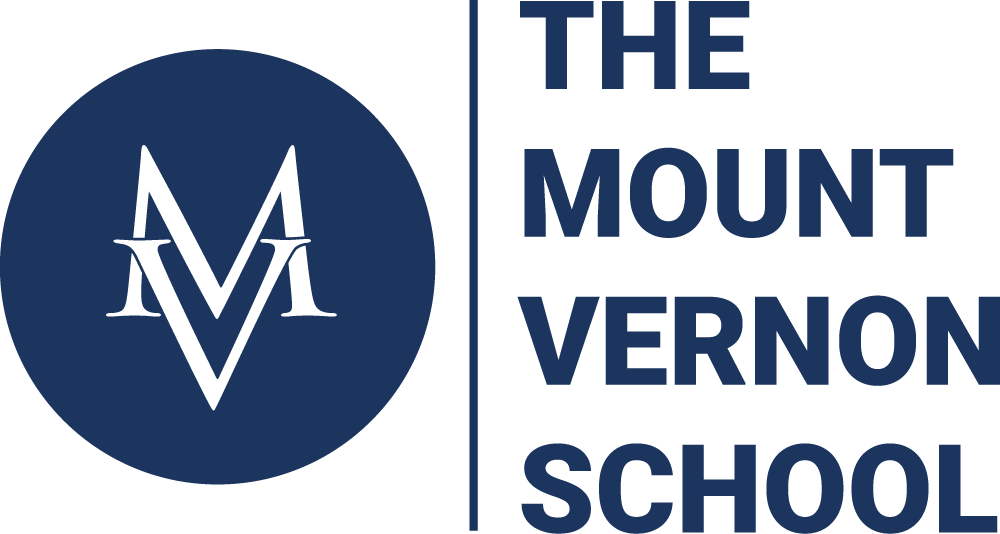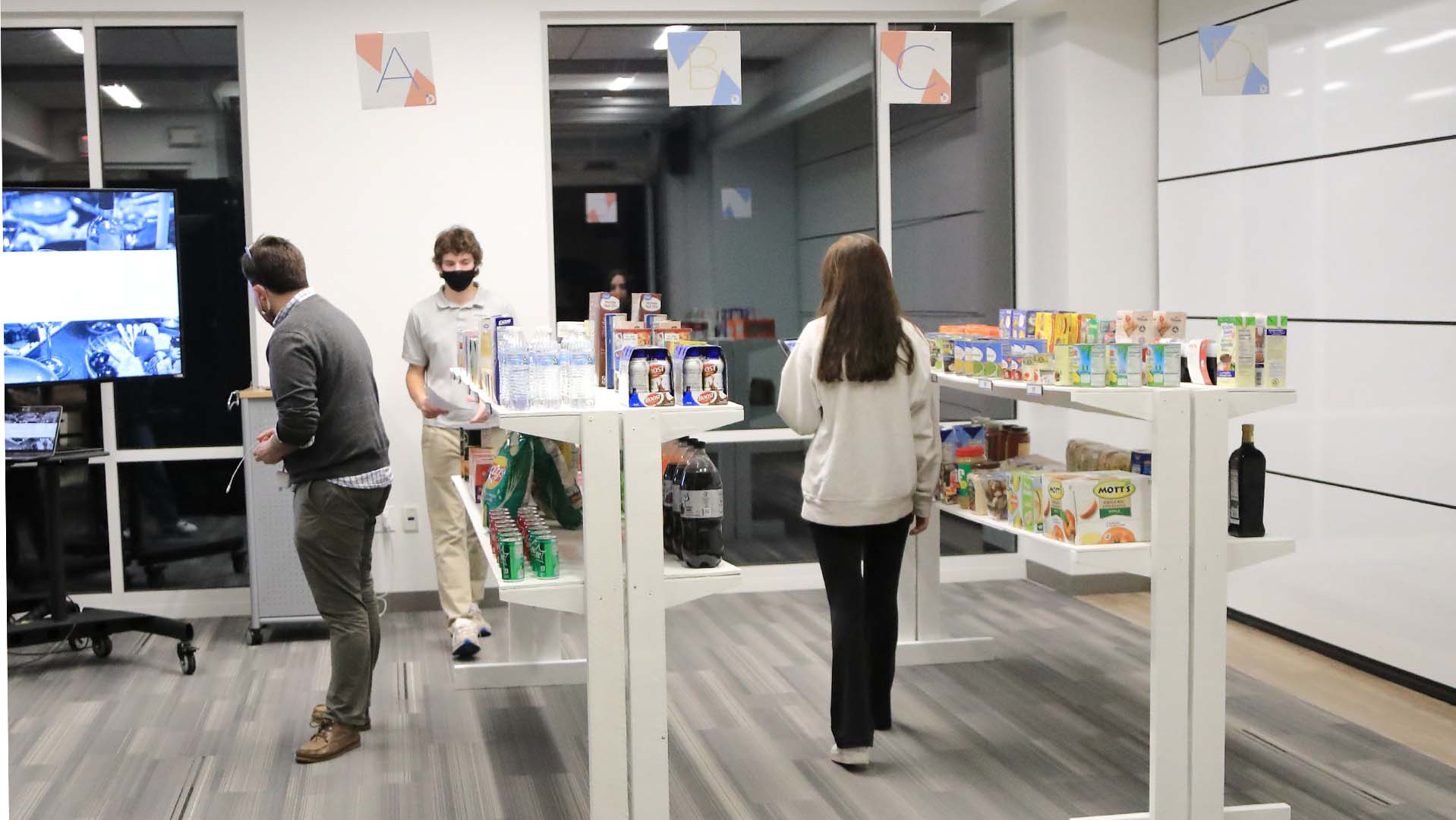Contributed by Director of Innovation Diploma Brad Droke and Innovation Diploma Students
Upper School, Innovation Diploma students created retail pop-up shops addressing what the future of retail could look and feel like. This was also an opportunity to showcase our ability to create scale prototypes while highlighting the importance of truly understanding a problem before creating a solution. Students presented their work for feedback and to address questions to a panel of MVXperts that included executives from Accenture and Mercedes Benz. Read about each of the 4 team’s experiences below from the students themselves.
iD Market
The problem we were faced with was to redesign a specific shopping experience. We decided to focus on the grocery store. As a group, we saw that from customer service issues, to long lines, and inconvenience in finding your desired item, the grocery store was in need of a change. We first added a simpler aisle system. The shelves inside are still double sided, but they are shorter and easier to navigate in terms of visual appeal. We added a letter and number system, so when you connect to the added app, it would tell you which number combined with its letter your product is in.
Along with our app, we included an AR system to help guide you to your desired product. The app shows a visible set of arrows to help guide you. For payment, we decided to make it connected to our shopping cart, so that when you leave you won’t have to wait in any long lines. Finally, we came up with the personal meal plan and conveyor belt system. The meal plan system provides an easy questionnaire that gives you a new meal to try out based on what answers you choose. Then, a pre-prepared meal will come out via the conveyor belt. In conclusion, we, as a group, redesigned the grocery system through the usage of modern technology and navigation concepts.
- William Nix, Class of 2023
Magic Mirror
We started by identifying what works in the retail market now. We had to know what was effective to know what could be improved. This led us to research methods of optimizing the shopping experience. We analyzed the effects of lighting, spacing, and store layout and the roles they played in a customer’s shopping experience. Then we defined our focus, what about the future of retail did we want to impact? What would actually matter in the future? This brought us to the intersection between digital and brick and mortar shopping. We landed on big data and biometrics as our focus. Our goal was to create a seamless transition between digital and in person to create a more efficient shopping experience. We designed an interactive user interface that was built into a smart mirror which would use facial recognition to collect user data and tailor the shopping experience to each person. This would allow customers to save their data on their phone and access their account on the mirror to add items into your cart and even place online orders. That was the impact, the seamless transition of data from digital to in person while maximizing the benefits of both.
- Reed Garzon, Class of 2022
Shoe Store
As a design brief team, we decided to story-tell the future of retail through the lens of shoe shopping. We decided that shoe shopping was reliant on the development of experiential shopping as well as the implementation of trendy aesthetics and technology. As a team, we delved deeper into the problem of in-store shopping becoming obsolete, exploring retail stores and malls around Atlanta. Stores that were simplistic and implemented technology into their experience with fluidity created a modern spin on the shopping experience that did not break away from the traditional experience we all are familiar with. Once we decided this was the direction we wanted to go, we pursued it, developing a list of things we disliked and liked with the shoe shopping experience. We landed on one particular problem that we decided would be the most beneficial to solve, and that was the awkward interactions asking for shoes. Brainstorming as a team, and using inspiration from other retail stores, we decided we would use a tablet to order shoes as well as add the descriptions and reviews of each pair. Designing and implementing the shoe store was an immersive experience. We had one classroom and $500 dollars to make our store come to life. With shoe experts on our team, the store came together smoothly and our presentations went without a flaw.
- Will Allison, Class of 2022
Fitting Room
When trying to broach the topic of “Redesigning the Future of Retail” our team latched onto a problem that has been plaguing the retail industry for decades: Fitting rooms. They were far too cramped, messy, and completely destroyed the flow of the shopping experience. There had to be a solution, and we were going to be the one who made it a reality. We started with research, after field visits, interviews, and current market research we found three design drivers which led our work for the rest of the project. The first being fitting rooms are too cramped and make customers uncomfortable, this inspired us to make our prototypes more spacious and welcoming. The second design driver was that customers are much more likely to buy a product if they enter a fitting room first, which led us to move the checkout counters to right outside the fitting rooms making it convenient to go and try on an item before purchasing it. Our third and final design driver was that customers hated having to leave a fitting room to go find a different size or color of the clothes they had just grabbed. This leads us to create our biggest innovation, a closet system that actually allows for customers to call for new clothes to be placed inside their room. This system would avoid the hassle of customers having to leave the fitting room to find a new ize, and would inspire them to try on even more clothes. All of this design and research work culminated in the creation of a full scale fitting room that included all of the innovations inspired by our three design drivers. As we presented it to experts in the field, the fitting room became a tangible experience showing what the future of clothing retail could look like.
Liam Adams, Class of 2022
Innovation Diploma is a student-led, transformation design studio that inspires, creates, and implements high-impact work at Mount Vernon. The program culminates with students creating long term professional relationships, facilitating positive change in partnered organizations and communities, and having an active role in changing the world around them.
Learn more about iD by hearing students share their experiences on this episode of the Made in MV Podcast.







